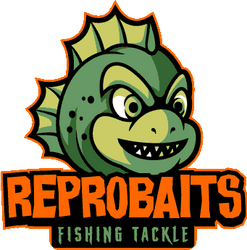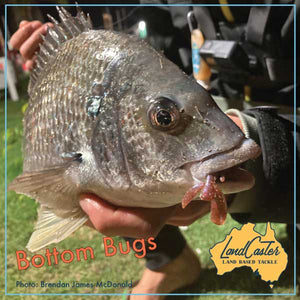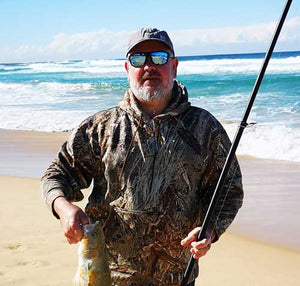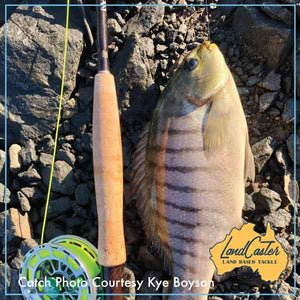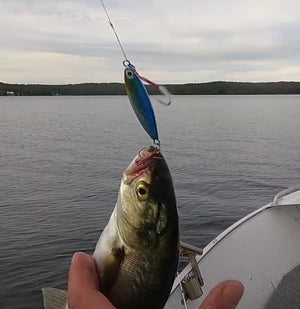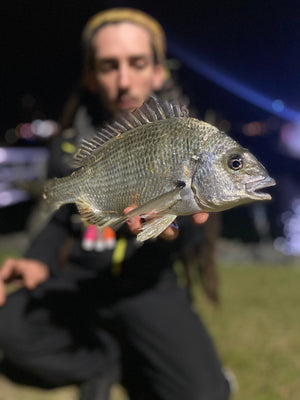
Chasing the Elusive Bream: A Young Angler's Guide to Mastering Bream Fishing
🔔 Get the Best Soft Plastics for Bream & Flathead!
Shop our most popular soft plastics today:
✅ Bottom Bug – Realistic Crayfish Lure
✅ Squideez Soft Plastic – Perfect for finesse estuary fishing
✅ Bullet Prawn – Irresistible prawn action for flathead
📦 Fast Aussie Shipping – Order Now!
The Critical Role of Structure in Bream Fishing
In the diverse and rich waters of New South Wales and all across Eastern Australia structure plays a pivotal role in successful bream fishing. This is true, especially, within the myriad of lakes dotting this region. Structures such as submerged trees, rock walls, jetty pylons, and even artificial reefs provide critical habitat for bream offering them protection from predators and abundant feeding opportunities. These areas are magnets for smaller prey making them ideal spots for bream to hunt and, consequently, prime locations for anglers to target.
The presence of structure in these waters adds complexity to the fishing environment requiring anglers to adopt a nuanced approach to their tactics. Successful bream fishing around these structures involves not only understanding the habits and preferences of the fish but also mastering the art of casting with precision to place lures or baits close to or within these habitats without snagging. The diversity of structure in New South Wales' lakes and throughout Eastern Australia means that anglers must be versatile in adapting their techniques to the specific type of structure they're targeting.
Whether it's adjusting lure selection for the depth and cover of a submerged log or fine-tuning retrieval techniques to mimic the movement of prey around rocky outcrops the intricacies of fishing these structured environments can be both challenging and rewarding. Recognizing and leveraging the importance of structure in these settings is a testament to an angler's skill and understanding of the ecosystem often making the difference between an average day on the water and a memorable fishing adventure.
Essential Fishing Gear: Choosing the Right Line and Rod for Bream
Selecting the right rod and line is fundamental for successful bream fishing in the saltwater lakes of Eastern Australia, where the conditions and the cunning nature of bream demand precision and finesse. For rods, a light to medium-light action is ideal, offering the sensitivity needed to detect subtle bream bites and the flexibility to cast lightweight lures and baits accurately. A length between 7 to 9 feet allows for better casting distance and control, essential for reaching into tight spots around structures or covering more water from the shore or boat.
When it comes to line choice, bream anglers often favor braided lines for their mainline due to their no-stretch properties, which provide superior sensitivity and allow for immediate hook sets. A thin diameter braid in the range of 4-8 lbs test is typical, offering a good balance between strength and the ability to cast small lures or baits with precision. However, because braid is highly visible in water, attaching a fluorocarbon leader of about 2-4 lbs test is advisable. Fluorocarbon is nearly invisible underwater and adds abrasion resistance, which is particularly useful when fishing around sharp oyster beds, rocks, or other abrasive structures. This combination maximizes your chances of success, allowing for stealthy presentations and effective lure control in the diverse and often clear waters of Eastern Australia's saltwater lakes.
Knot Tying Techniques: Mastering the FG Knot for Bream Fishing
When connecting your mainline braid to your fluorocarbon or monofilament leader it's tempting to use a swivel for convenience. However, this approach can significantly hinder your fishing success and even damage your equipment. Swivels can restrict the natural movement of your lure, preventing it from mimicking the subtle, lifelike actions that entice bream to bite. The more direct connection achieved through knot tying, such as using the FG Knot, allows for a seamless almost invisible transition between line and leader giving lures the freedom to move as intended.
Swivels also can become a point of weakness not only in your line but also a hazard for your rod. During casting or when reeling in a catch a swivel can hit the rod tip guide potentially causing damage over time. This damage can affect the rod's performance leading to unexpected breakage when casting or fighting a fish. By opting for a direct line-to-leader connection you eliminate this risk ensuring both the integrity of your rod and the effectiveness of your lure presentation. Knots ultimately contribute to a more successful and enjoyable fishing experience.
Advanced Tactics for Increasing Bream Hookups
Precision Casting: The Key to Stealthy Bream Fishing
For Bream anglers the ability to cast with precision is not just a skill—it's an essential strategy especially when targeting structures like oyster leases and pilings. These areas are hotspots for bream as they provide abundant shelter and food sources. By casting your lure close to these structures you significantly increase your chances of eliciting quick bites from bream lurking in the vicinity. However, this approach requires not only accuracy but also an understanding of how to position your lure to avoid snags and hang-ups which are common challenges in such complex environments.
Accurate casting allows you to place your lure exactly where the bream are most likely to be without disturbing their natural habitat or losing your gear. This level of precision minimizes the risk of entangling your line in the lease or piling ensuring your fishing trip remains productive and frustration-free. Mastering the art of casting near these structures can lead to thrilling encounters with bream as they are often more aggressive in their territorial waters. Developing this skill takes practice but the payoff is worth the effort, as it opens up new opportunities for successful catches in areas where bream feel secure.
Leveraging Light and Shadow for Bream Fishing
Bream prefer shaded areas around structure like pilings and oyster leases. Paying attention to the movement of the sun can help prioritize fishing spots for better results. Cast into shadows and avoid having your shadow fall on where Bream may be hiding. Bream will often hand around the shadows in shallower water. Casting accurately from far away can be the best tactic to get a big take from wary Bream patroling these areas.
Understanding Tides and Currents in Bream Fishing
Understanding the interplay between tides and structure is crucial for successful bream fishing in saltwater lakes like Wallis Lake and Lake Macquarie in New South Wales. These dynamic environments are influenced by the ebb and flow of tides which significantly affect bream behaviour and their location within the water. During incoming tides bream tend to move closer to shorelines feeding around structures such as oyster leases, oyster encrusted rocks, and submerged structure. This is the prime time for anglers to target these areas as the rising water levels bring bream in search of food during this period.
During outgoing tides bream may retreat to deeper channels and holes near these structures where the water movement concentrates their food sources. Understanding this tidal movement allows anglers to adjust their strategies focusing on areas where bream are likely to congregate. By aligning your fishing efforts with these tidal patterns you can increase your chances of encountering bream as they move through the lake's ecosystem exploiting their natural behaviours for more effective fishing.
Lure and Jighead Selection for Effective Bream Fishing
Select jigheads based on current strength and water depth with lighter options for a more natural lure descent that can entice bream to bite. Smaller soft plastics with lighter weights can be cast accurately and for an extended amount of time.Bottom Bugs andSea Bugs from ReproBaits Tackle are excellent and tried and true soft plastics chosen especially for their effectiveness on Bream. A nice worm hook is a perfect match and can be rigged weedless to help reduce snags and lost tackle ultimately saving precious fishing time. With or without a small weight such as a ball sinker or even a weighted jig head depends on tide, location, depth, and even the preference of big wary Bream. There are more suggestions forBream tackle on the ReproBaits website.
The Importance of Adaptability in Bream Fishing
Adaptability is a cornerstone of successful bream fishing. This is a skill that separates the casual angler from the seasoned pro no matter what species of fish you target. The ever-changing conditions of waterways, influenced by weather, tides, and seasonal shifts demand a flexible approach to fishing strategies. Paying close attention to these environmental cues such as changes in water temperature, clarity, and current flow can provide insightful clues into Bream behaviour at any given time.
An angler’s willingness to adjust tactics, whether it be switching lure types, modifying retrieval speeds, or even relocating to different fishing spots can dramatically increase the odds of a successful catch. Observing the subtleties of the environment and bream activity and being prepared to pivot strategies accordingly is essential for those looking to enhance their bream fishing proficiency. This adaptability not only leads to more productive fishing outings but also deepens an angler’s connection with the natural world enriching the overall fishing experience.
Advanced Strategies for Bream Fishing Success
Stealth and Observation: Essential Skills for Catching Bream
Mimicking Prey Movements to Attract Bream
Mimicking the natural prey of bream is a nuanced art that significantly enhances the effectiveness of your lure particularly when using soft plastics in saltwater lakes. The key to success lies in understanding the movements and behaviours of the bream's natural diet such as small fish, crustaceans, and insects, and replicating these actions with your lure. Soft plastic lures with their lifelike flexibility can be twitched, paused, and retrieved in patterns that mimic wounded or fleeing prey tapping into the predatory instincts of bream. But the strategy doesn't stop at soft plastics; incorporating bait and hardbody lures into your arsenal offers a variety of presentations that can appeal to bream under different conditions. Bait presents a scent and texture that can prove irresistible while hardbody lures with their built-in action and ability to cover a range of depths can mimic the erratic swimming of small baitfish. Combining these approaches matched with a keen observation of the lake's current conditions and bream behaviour allows anglers to present a compelling imitation of bream prey enhancing the chances of a successful catch in the diverse environments of Australia's saltwater lakes.
Equipment Care: Maintaining Gear for Bream Fishing
Maintaining your fishing gear is essential for ensuring its longevity and optimal performance, especially after targeting bream in saltwater environments. Saltwater is particularly corrosive, and capable of damaging reels, tackle, and other components if not properly cared for. After each fishing session, it's crucial to thoroughly rinse your reels, rods, and all tackle with fresh water. This simple act washes away salt residue and particles that can accumulate in the moving parts of the reel along the rod guides and on lures or hooks.
For reels a gentle rinse under a low-pressure stream of fresh water is sufficient to remove salt without forcing water into the internal mechanisms. Allow the reel to dry completely before storing it to prevent any rust or corrosion. Rods should also be rinsed and wiped down paying special attention to the guides where salt and grime can erode the protective coatings. Tackle, including lures, hooks, and swivels, should be rinsed in fresh water and dried thoroughly.
Periodic maintenance such as lubricating reel gears (with Inox) and checking for wear or damage will keep your equipment in top condition. By adopting a routine of cleaning and care after each saltwater outing anglers can protect their investment and ensure their gear is always ready for the next bream fishing adventure.
Conclusion: Patience, Skill, and Environmental Awareness in Bream Fishing
Understanding bream behaviour, selecting the right equipment, and being open to trying different techniques enhance your chances of a great catch. Each fishing attempt offers a new adventure promising the thrill of bream fishing with dedication and a bit of luck. Like anything, Bream have their specific behaviours and learning them through repeated fishing sessions will help you get better at catching Bream. A session fishing for Bream in which you caught nothing is not unsuccessful if you learned something about fishing for Bream. Fishing is a learning experience and each session you fish you should learn something from whether you catch nothing or a stonker of a specimen. Tight lines and good luck while out enjoying your time outdoors!
🔔 Get the Best Soft Plastics for Bream & Flathead!
Shop our most popular soft plastics today:
✅ Bottom Bug – Realistic Crayfish Lure
✅ Squideez Soft Plastic – Perfect for finesse estuary fishing
✅ Bullet Prawn – Irresistible prawn action for flathead
📦 Fast Aussie Shipping – Order Now!
